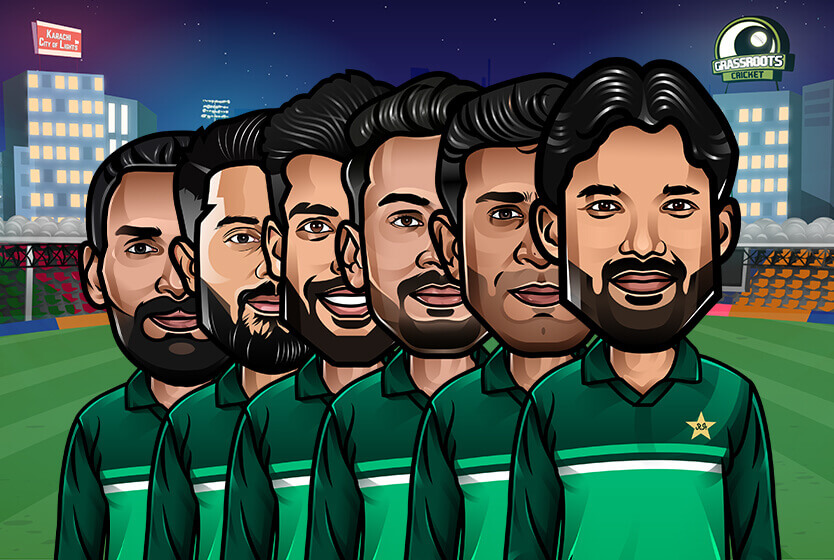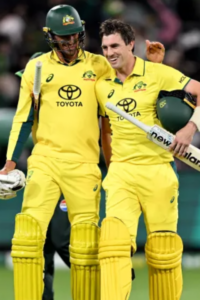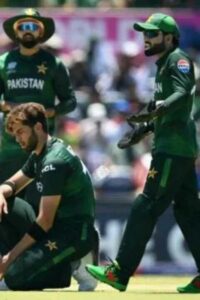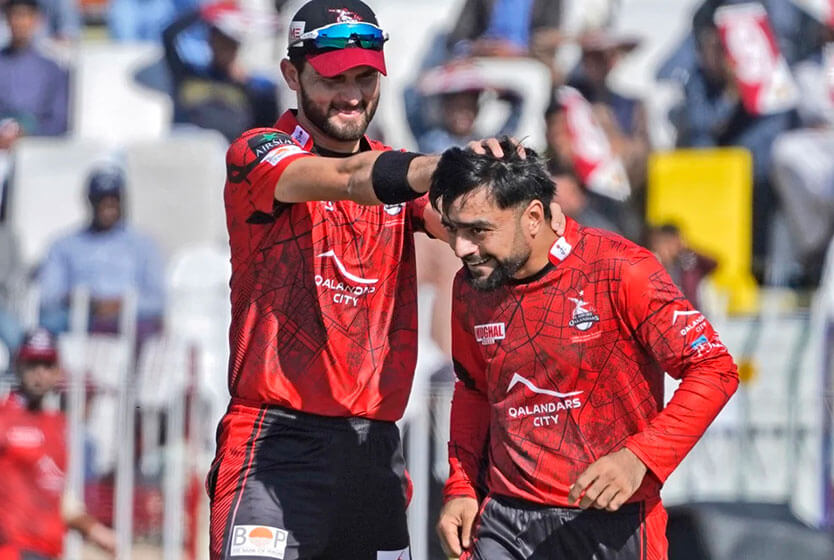
Assessing Pakistan’s ODI Middle Order Conundrum
One year before the 2023 ODI World Cup in India, Pakistan’s middle-order is shaky and unsettled.
England were 86/4 in a World Cup final. They required 156 more runs in 27 overs, a required run-rate of 5.8 on a pitch where the highest SR for anybody who had played more than 20 balls was 83 (4.98 RPO). At No.7, they had Chris Woakes, who until recent times had been batting at 8; that may not seem like a significant jump but it was. No longer did England have the services of Moeen Ali at No.7. The fact of the matter was that until and unless this 5th-wicket partnership dragged England to within 50 runs of the target, they can kiss their chances of a maiden World Cup win goodbye.
England’s No.5 and 6 stepped up. But it wasn’t a surprise to anyone; they had been doing the same thing for their team for the past 3 years, now they were going to do it on the biggest stage. Stokes would obviously take most of the glory for being the man to stay till the end, but Jos Buttler scored at a run-a-ball on a pitch where batsmen struggled to score at over 5 RPO. They both recovered the innings while managing to keep the required run-rate in check, an extremely wobbly tightrope to walk even without the pressure of a World Cup final.
What do the pairs of Shane Watson & Glenn Maxwell, Yuvraj Singh & MS Dhoni, Andrew Symonds & Michael Hussey, Andrew Symonds & Michael Bevan, Steve Waugh & Michael Bevan have in common? They are all World Cup winners batting at those crucial No.5 and 6 positions. They perfected the art of enhancing a par score set by the top order or recovering the innings at a rate that wasn’t detrimental to the team’s chances of a win. Because ultimately, the World Cup is a long and grueling tournament, especially in its current format. Eventually, the top order will fail, and that’s where good teams are separated from the greats.
So what does this all mean for Pakistan? It means they should simulate till the next World Cup and then try again because there is no one remotely ready to take up the mantle of all the greats previously mentioned. That isn’t the fault of the players but as always with Pakistan cricket – the haphazard management of them.
There is no substitute for experience. You identify the players that will succeed in that position, and then you back them to the hilt. Obviously, identification is key because these players need to be able to switch gears at will while also not troubled by any type of bowling. The results will rarely present themselves immediately. Rather, they will start to show after 20 or 50 innings in that position. To groom a No.5 or 6 requires a good eye and a great deal of patience.
| Average | Strike Rate | |
| Stokes after 20 inns | 14.2 | 72 |
| Stokes after 50 inns | 29.6 | 98 |
| Buttler after 20 inns | 27.7 | 128 |
| Buttler after 50 inns | 31.1 | 109 |
| Watson after 50 inns | 29.4 | 74 |
| Symonds after 50 inns | 29.4 | 90 |
| Yuvraj after 50 inns | 24.3 | 99 |
| Maxwell after 50 inns | 34.2 | 126 |
Pakistan have approximately 20 ODIs leading up to the 2023 World Cup – some of those will be against lower-ranked or weakened teams. In most of those, the top order will do most of the work. Thus, we may only see the lower-order truly tested 5 or 6 times at most leading up to the World Cup. Knowing Pakistan, major personnel changes will be made on the back of those 5 or 6 innings. A decision has to be made immediately about what type of team Pakistan wants to be. Do they want to bat deep or play five frontline bowlers; do they want a reliable 6th bowling option? There is also the No.4 problem that needs to be resolved due to the ill-advised Saud Shakeel experiment, so let’s start with that.
Candidates for No.4
The Pakistan Cup is the most neglected top-level domestic competition in men’s cricket, and it is understandable why. The PSL is the pinnacle of the domestic calendar, the Quaid-e-Azam trophy is the premier FC competition, and the National T20 is easily marketable because it’s T20 cricket. Thus, the Pakistan Cup finds itself thrust to the end of the calendar when players have international commitments or are marred by injuries. The level of competition is low, and the pitches are extremely flat. So much so that if any batsman wants to score the amount of runs required to be noticed, he has to bat in the top 4. Thus, you will find many candidates for opening, No.3, and No.4, even if the No.4s may actually be walking in at an entry point of a No.5 or 6 on normal occasions due to the slower pace of fall of wickets.
| Batting at No.4 in List A | Inns | Runs | Average | Strike Rate |
| Mohammad Rizwan | 45 | 2001 | 58.9 | 96 |
| Salman Ali Agha | 20 | 840 | 46.7 | 92 |
| Iftikhar Ahmed | 43 | 2109 | 55.2 | 104 |
| Khushdil Shah | 18 | 883 | 63.9 | 94 |
| Asif Ali | 12 | 596 | 49.7 | 118 |
| Saud Shakeel | 8 | 324 | 46.3 | 87 |
| Kamran Ghulam | 6 | 175 | 29.2 | 80 |
Saud Shakeel and Kamran Ghulam will go on to be excellent Test players; it is obvious that they are among the best batting talents in the country. However, in ODIs, they are suited to the top order, with a majority of their domestic runs scored at No.3. In domestic cricket, they have not as of yet shown the rate of run-scoring that would suggest they could play lower than No.3. From 2015 to 2018, Saud averaged 70 in domestic one-dayers but at an SR below 90, While Kamran scored over 500 runs in the Pakistan Cup this year, he too did it at a similar SR to Saud.
On paper, all of the other names mentioned in the table present as excellent candidates to take up the No.4 spot but positional numbers are not able to illustrate the game situation the runs may have been scored in. In addition, usually, these players are among the best in their team, and thus, their teams want them to face the maximum amount of balls, depending on them to overcome the minor hurdles that the bowling may present. Thus, teams will send them higher up the order, where they score runs and push for inclusion in the national team. But for the reasons mentioned above, Pakistan Cup numbers need to be taken with a grain of salt, and we could look to other formats to assess player durability and explosiveness.
So what do teams look for in an ODI No.4? Well, it depends on the team’s makeup – do you need someone to help set up the platform or begin the launch? In Pakistan’s case, they will lean towards platform setting because although their openers are reliable, they do at times depart early in quick succession, and you require your No.4 to arrest that slide. A secondary requirement for most ODI No.4 is an attacking game against spin, not specifically hitting but someone who will not let the spinners settle and easily rotate them.
So Pakistan needs someone durable (his longer format numbers will help ascertain that), attacks spin, has experience batting at No.4, and plays at a modern strike rate. Khushdil and Asif Ali’s FC numbers do not inspire confidence, while Iftikhar’s stronger suit is pace. Salman Ali Agha is widely considered among the best players of spin in the country, has excellent List A and FC numbers in the past two years, and plays at a good rate in both formats. On the face of it, he looks like the best candidate to take up the No.4 spot.
Rizwan has batted at No.4 not only in the Pakistan Cup but also for Pakistan A and the national team. He has two ODI 100s batting at No.4, and that is his best position thus far judging by positional stats in ODIs. While Rizwan has greatly evolved as a player, maybe Pakistan were expecting a bit too much of him by hoping he will crack the difficult No.5 spot in ODIs. Perhaps it’s time to give him the relatively easier job where he has a history of being successful.
| Position | Inns | Runs | HS | Avg. | SR | 100s | 50s |
| 4 | 12 | 392 | 115 | 35.6 | 96 | 2 | 1 |
| 5 | 6 | 106 | 67 | 17.7 | 75 | 0 | 1 |
| 6 | 15 | 339 | 75* | 30.8 | 83 | 0 | 2 |
| 7 | 5 | 46 | 16 | 11.5 | 92 | 0 | 0 |
| 8 | 1 | 14 | 14* | – | 74 | 0 | 0 |
He has the durability, as indicated by his excellent Test record, and he has the ability to play at the rate required of a modern-day No.4. The only drawback he has in comparison to Agha is his game against spin. He has shown a tendency to at times get stuck at the crease, particularly vs. away spin. But Pakistan will hope that Rizwan, as he often does, finds a way. Because ultimately what they do not need is a repeat of the 2017-19 situation where their wicket-keeper was clearly suited to a middle-order role but kept being pushed down to the lower order, which effectively shortens the batting lineup.
Candidates for No.5
As we shift from No.4 to No.5, the emphasis on the ability to play spin decreases, and we become more focused on the batsmen’s ability to tee off at the death. This is only to a certain degree as teams can be 30/3, requiring their No.5 to recover the innings before teeing off at the death. Indeed, teams do not shy away from utilizing spinners in the last 10 overs of the innings these days, thanks to the greater protection of five fielders outside the circle. It is here that Pakistan will have to make a decision because there is only one Ben Stokes, and he plays for England.
Iftikhar Ahmed has been around for a long time, but his push for inclusion in the national ODI team began in 2017. From 2017 to 2021, he has 1735 runs in domestic one-day cricket at an average of over 60 and at greater than a run-a-ball. He even has a decent FC record to boot and bowls some handy off-spin that will complement the away spin of Shadab and Nawaz. But what may hold him back is his game against spin, especially considering Pakistan may have a 4, 5, and 6 of Rizwan, Iftikhar, and Khushdil, all three of whom are stronger vs. pace than spin. Now that problem could be partially rectified by floating someone like Shadab in the middle order, as he is a stronger player of spin and scores at a decent rate against it. Iftikhar’s domestic numbers say he deserves a shot to succeed at No.5; Pakistan can give him a proper run and then judge if he’s fit for the job.
It is unlikely that Salman Ali Agha will get his ideal batting position of No.4 but could he perhaps be what Pakistan needs at No.5. In terms of batting, he is the opposite of Iftikhar, with a better spin than pace game. But at No.5, Pakistan will need someone who possesses power vs. pace, and it remains to be seen whether Salman will be able to rise to that challenge. He also bowls off-spin like Iftikhar, which could be useful for a World Cup in India. Since 2020, Salman has scored 609 runs at an average near 50 and at an SR over 100.
Pakistan will need to decide if they are confident enough in their top order and Shadab’s ability to shield the middle order from spin. If they are, then Iftikhar has a greater body of work and should get a proper shot to succeed, if they are not, then it may be Salman’s time to get a shot.
Candidates for No.6
Pakistan have only two candidates for No.6 – Khushdil Shah and Asif Ali. From 2017 to 2021, Khushdil has 1474 runs in domestic one-dayers at an average of over 60 at an SR of over 100. In addition, he has shown great improvement in recent times, with his pace power game, in particular, among the best in the country. Add some handy left-arm spin to the mix, and he seems a front runner for the No.6 spot.
Asif’s case is that while he might not be as consistent as Khushdil, he will perhaps be more destructive. From 2018 to 2021, in domestic one-dayers, he has averaged 48 at a scarcely believable SR of 120. But while Khushdil has scored every year, Asif has peaks and troughs. He will average over 50 in one tournament and then average under 30 in the next, while Khushdil averaged 45+ in every tournament from 2017 to 2021. So while Asif might be destructive, he could be too unreliable for Pakistan to confidently go into a World Cup with.
Left-Field Ideas
Shadab and Nawaz
Shadab Khan and Mohammad Nawaz have greatly improved their batting in the past few years. With them at 7 and 8, Pakistan can boast that they have “batting depth”. Nawaz averages over 30 in List A cricket at SR near 90, with a 100 to boot, while Shadab can effectively play as a batsman in T20s if he’s in form. Could Pakistan utilize them better to open up a luxury spot?
If Shadab and Nawaz were to share the responsibility of batting at No.5, Pakistan could effectively play an extra player at 7 or 8. That could be Asif Ali, who may not be reliable enough for No.6 but would be an absolute ace up Pakistan’s sleeve at No.7. Alternatively, Pakistan could field a more varied bowling attack, perhaps the reverse of Mohammad Wasim or the wile of Usman Qadir. But this will only be possible if Pakistan are confident enough in the batting abilities of Shadab and Nawaz. Thus far, there has been no indication that they are.
Haider Ali
Haider Ali is among the finest batting talents Pakistan has produced in the past 10 years. His ability to play spin is supreme, and he possesses the power to take on the pacers. In an alternate universe, he was given a proper run at No.4 where he cemented his position for the next 15 years, and Pakistan would go into the World Cup with a No.4 who makes sure the spinners will not be allowed to bowl. Unfortunately, that is not this universe. Haider is suffering from a severe lack of form. The last thing he needs is to be thrust into a dysfunctional middle order and be expected to figure out how to bat in the hardest position to bat in ODIs without any prior experience.
Shan Masood
There are 3 batsmen who have scored over 1000 runs at No.5 since 2016 – Ben Stokes, Angelo Matthews, and Tom Latham. Matthews’ SR in that period has been less than 80, but Latham has managed to score at the same rate as Stokes despite being virtually unsuited for the role. Latham was an opener by trade but New Zealand needed a wicket-keeper, and their opening combo was set at Guptill-Munro. So Latham was expected to bite the bullet and slot in at No.5. He has done surprisingly well for himself, averaging over 40 at an SR of over 90. His excellent game vs. spin has helped, and he has managed to score at an SR of over 120 in the last 15 overs of ODI innings.
Shan Masood has been knocking on the selectors’ door for a long time in ODI cricket, but he has found himself frozen out because of the extremely successful pairing of Imam-Fakhar at the top. The cold hard numbers are that in the last 3 years, Shan Masood has averaged over 100 in domestic one-day cricket at an SR of over 90. Can Pakistan afford to keep him outside the team any longer? Could he emulate Latham and manage to crack the No.5 role? He has been attacking vs. spin in the PSL and is not troubled by pace, although that does not always translate to power vs. pace. But Shan doesn’t seem to be in the selectors’ ODI plans, not even being able to secure a place in the 20-man squad announced for the Australia series.
Conclusion
Pakistan are out of time – decisions that should’ve been made in 2019 are yet to be made. There is no way they can provide the candidates the required experience they will need to finish among the World Cup-winning No.5s and 6s mentioned before. Thus, they must rely on domestic experience. It isn’t perfect, with Pakistan Cup’s quality leaving much to be desired, but they have no other choice. Thrusting in inexperienced rookies into difficult roles will end up being detrimental to both the team and the player.
Pakistan need to decide what type of ODI cricket they want to play and then pick the team according to that ideology. They need to commit because it is already too late to make this decision, the only thing worse would be to make a decision and then renege on it after one loss. It is time to wake up.







Leave a Reply